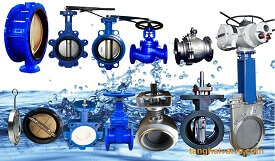Maintenance Methods of Common Valves
Common valve failures include leakage, opening and closing parts damage and failure, etc. One of the most important reasons for the valve failure problem is that the valve is not well maintained. The valve is an important part of the pipeline transportation system. Maintenance and maintenance can make the valve better serve us. At the same time, it can also prevent valve failure from the source and reduce production accidents caused by valve failure. Therefore, this article will talk about the maintenance methods of commonly used valves.

marine valve; butterfly valve; check valve; gate valve; manufacturer in China
1. For valves that are not in use for a long time, they must be cleaned regularly to remove dirt and dust on the exposed surface of the valve, and at the same time, they must be sealed to ensure that the inside of the valve is clean and dry. Store the valve neatly in a ventilated and dry place indoors, and it is strictly forbidden to stack it or store it in the open air. When storing, the butterfly valve is the easiest to store, just keep the butterfly plate in the closed state. For gate valves, globe valves and check valves, both ends of the passage should be blocked during storage, and the valve plate should be closed. The storage of the ball valve requires that both ends are blocked and in an open state.
2. Before installing the valve, you need to check the pressure and diameter of the valve again, and clean up the dirt on the valve during transportation.
3. When installing the valve, install the valve correctly according to the connection method of the valve. Generally, the commonly used valves can be installed at any position in the pipeline, but it is necessary to consider whether the operation of the operator is convenient after installation and whether it is convenient for future valve maintenance .
4. When the gate valve and ball valve are working, they are only used for fully open and fully closed. They cannot be used for flow adjustment, otherwise the sealing surface will be severely washed and corroded, and the opening and closing parts of the valve will be greatly worn.
5. When the handle valve and handwheel valve are opened or closed, levers, wrenches or other tools cannot be used to avoid damage to the valves.
6. Tighten the bolts on the valve packing gland evenly. Don’t beat the gland to make the gland tilt, which will damage or hinder the movement of the valve stem and cause valve leakage.
7. During use, the valve should be maintained regularly to keep the valve clean, and the transmission part should be regularly lubricated. Once the valve is found to be malfunctioning, it must be stopped immediately to find out the cause of the malfunction and clean up the malfunction.
TH Valve is a professional manufacturer of butterfly valve, gate valve, check valve, globe valve, knife gate valve, ball valve with API, JIS, DIN standard, used in Oil, Gas, Marine industry, Water supply and drainage, fire fighting, shipbuilding, water treatment and other systems, with Nominal Diameter of DN50 to DN1200, NBR/EPDM/VITON, Certificates & Approvals: DNV-GL, Lloyds, DNV, BV, API, ABS, CCS. Standards: EN 593, API609, API6D
Related news/knowledge:
Common failures of butterfly valves and the characteristics of installation
Installation and Maintenance of Butterfly Valve
Installation and maintenance of electric ball valve
Valve cleaning steps and assembly requirements



 © Copyright 2020 Tianjin Tanghaidongyang Valve Co., Ltd. All Rights Reserved.
© Copyright 2020 Tianjin Tanghaidongyang Valve Co., Ltd. All Rights Reserved.